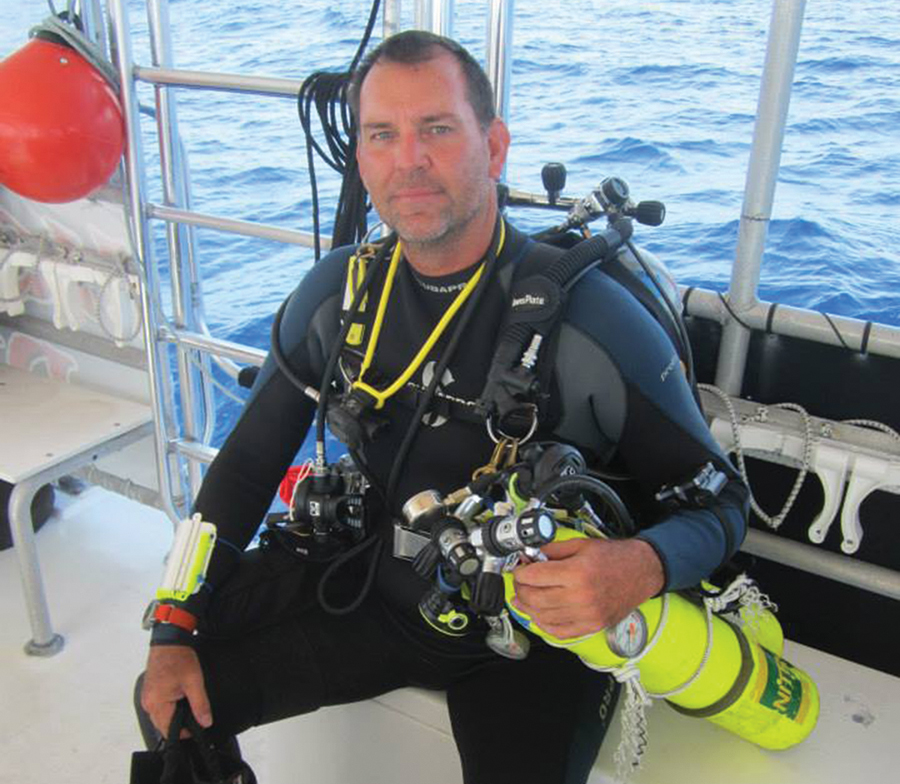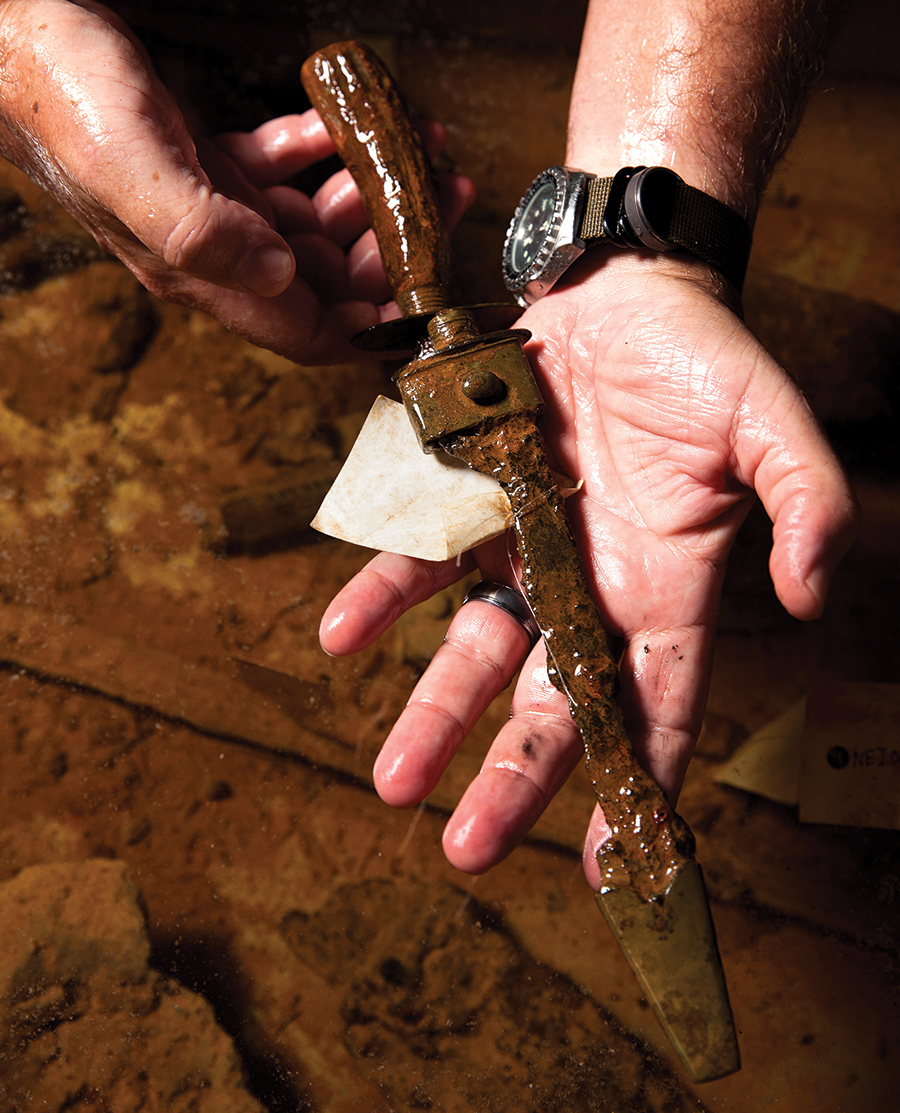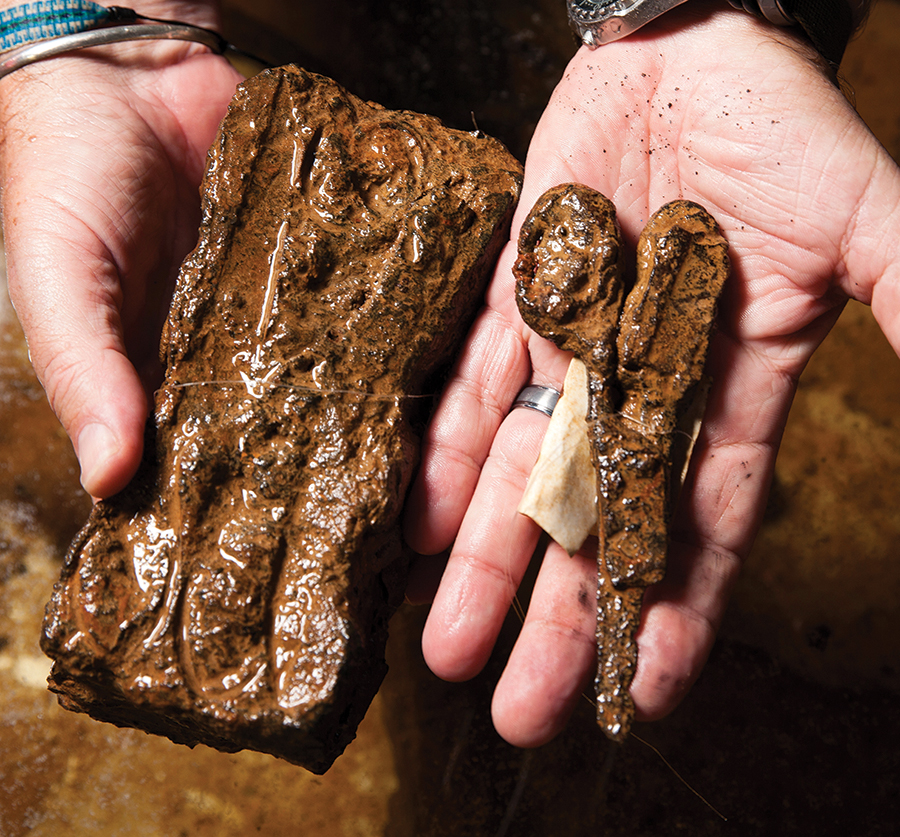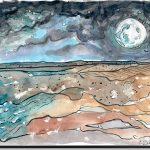A pair of colorful and passionate marine archaeologists bring the Civil War to the surface
Imagine Indiana Jones in a wetsuit and a mask instead of a leather jacket and a fedora. Forgo the melting faces of Nazis and the Thugee priest with that whole snatch-your-heart-out-of-your chest thing. Make it something more along the lines of a couple of guys with ribcages expanded from a lifetime of breathing underwater, advanced degrees on the walls and cabinet drawers stuffed full of charts and maps — guys who live and breathe a passion for finding and preserving the bits and pieces of our collective barnacle-covered heritage, even if they do get their air out of a tank. The deputy state archaeologist-underwater, John W. “Billy Ray” Morris III, and his archaeological dive supervisor, Greg Stratton, spend most of their workday researching databases at computers in a World War II-era cinderblock building tucked so far back in the live oaks near the entrance to Fort Fisher there’s a sign on the door that says:
Keep this Door Closed!
Snakes and other critters
are
Coming into the Building
So, at least they’ve got the reptiles covered, Indiana Jones-wise.
Morris is North Carolina’s fourth head of underwater archaeology. He met the first one, Gordon Watts, when he was 15 years old. “I was putting my wetsuit on to go surfing right behind that window right there,” says Morris, pointing out the back window of his office. “Gordon came wandering out and said, ‘What are you doin’?’ and I said, ‘I’m going surfin’ dude. What are you doing?’ and he said he was the underwater archaeologist for the state of North Carolina. I said nobody’s got that job.”
Now, Morris does and it’s as good a fit as a dive skin. You might as well say he began prepping for it before he was in grade school. His uncle David Midgely was an underwater demolition team diver in the Navy who took his young nephew under his wing, holding him below the surface with one arm and sharing his breathing regulator with him with the other from the time Morris
was 5 years old. After getting a degree at UNCW and a master’s in marine archaeology from East Carolina University, Morris built a globetrotting career out of combing through other people’s wreckage. Bermuda. France. Jamaica. Trinidad. Tobago. Ecuador. El Salvador. California. Canada. Labrador. Mexico. Nevis. St. Eustatius. The Bahamas. Spain. And, most especially, Florida, where he created the Lighthouse Archaeological Maritime Program. “If I’ve missed any, they’ll come back to me,” he says.

“I spent 15 years every summer working for the Naval History and Heritage Command on the CSS Alabama off the coast of Cherbourg in France,” says Morris. “Then I spent five years hanging out in Bermuda working on a Spanish messenger vessel called a patache. We recovered that entire vessel, which is kind of a rarity.” Fresh from graduate school, Morris worked on one of Lord Cornwallis’ scuttled ships in Yorktown. “We did a bunch of crap with BBC and National Geographic for that one,” he says. “But, the project that will always stick with me is the Alabama. To get to dive on that wreck was really special, plus we got to live in France three months out of the year. I had absolutely no complaints about hanging out on the French coast every summer.”
The Alabama, commanded by the legendary commercial raider Raphael Semmes, was sunk by the USS Kearsarge in a celebrated naval battle in 1864. Éduard Manet recreated the engagement in a painting that hangs in the Philadelphia Museum of Art. “It was 220 feet deep,” says Morris of the Alabama wreck. “We did the work with the French Navy because it’s inside a French exclusion zone for a nuclear submarine base. Gordon Watts was the project director. Because of the depth we had to wear two tanks on our backs, two tanks under our arms and another one on our stomachs. You only had an hour and 15 minutes that you could work on the site before the current got so bad it would blow you to England.”
Just a routine day at the office, except maybe for that time Morris’ regulator blew at 200 feet. He and Watts buddy-breathed their way to safety. “I don’t think Gordon’s heartbeat even went up,” says Morris. “When we got back to the boat I suggested it was time for a few adult beverages.”
It was, after all, France. “We would stagger three dive teams five minutes apart. First group would start something, second group would do most of the work, third group would clean up. We managed to intersperse it with cheese and red wine. I was not one of the divers that drank a glass of red wine and then dive, but the French Navy guys, they’d polish off a couple of glasses while they were suiting up. I’m like, how can you do that? They’d say, we’ve done it from birth. Those guys were really, really good.”
The wreck in Bermuda was a small messenger vessel that went down in 1582. “I made a series of research models that are on exhibit in the National Museum of Bermuda,” says Morris. “When conservation is completed we’ll put the ship back together as a focal point for the museum’s display. They took one of the site drawings I made and used it for the back of the $50 bill in Bermuda, which was really cool. I called my parents and told them. When it came out they gave me bill 00001 and I insured it and mailed it to my mom. She gets it and she’s like, ‘Your picture’s not on it, Bill.’ ‘That’s the Queen,’ I said, ‘I drew the picture on the back, Mom. They like me there but not that much.’”
If Morris is built like a linebacker, the position he played at Wilmington’s John T. Hoggard High School, Stratton looks like he could play tight end for his beloved University of Texas Longhorns. Born and raised in Beaumont, Stratton was living in Austin before moving to North Carolina. “I came to this later in life,” he says of his archaeological career. “I was a home builder and I was in the military for eight years before that. I waited until both my children graduated high school. I decided to go back to school for what Dad wanted to do. Loved history. Loved archaeology. Started looking around for a degree that has it and I ended up at East Carolina.” And, ultimately, in an office that’s hardly more than a few football fields away from the largest collection of Civil War shipwrecks in the United States.

The Cape Fear Civil War Shipwreck Discontiguous District is listed on the National Register of Historic Places. Wilmington’s two channel passages (there’s only one now) at the mouth of the Cape Fear River, separated by the navigational obstacle of Frying Pan Shoals, was the lone holdout in the South’s desperate attempt to thwart the Union’s naval blockade. The wrecks of the ships designed specifically to slip through the blockade, along with a few unlucky Union blockaders, remain in the shallow waters so near to shore it seems as though you could wade out and touch them.
Blockade running was a dangerous, and lucrative, business. “Fifty percent of a blockade runner’s cargo had to be military in nature. That was Confederate law,” says Morris. “It took the boat owners and the captains about 30 seconds to realize this was the most lucrative trade on the face of the planet. You can look in the records of the Wilmington Journal or Charleston or Mobile. If you wanted the latest Paris fashion or good Scotch whisky, they brought that in and that was personal profit. There were captains that made so many successful runs they were wealthy men the rest of their lives. So, you got the best engineers, the best captains, the best sailors on those boats.”
The blockade runners were unarmed, fast and camouflaged. “These were the cigarette boats of their day, 221 feet long, super advanced,” says Morris. They had iron hulls, coal-fired steam engines and state-of-the-art paddlewheels. Nothing the Union had could catch them. “They went out to island entrepôts in Bermuda or Nassau or Havana, loaded up and sprinted in. They were painted a really, really pale gray. The masts and the funnels would either fold down or telescope down. The upper decks would be painted white. There are records of some of them being painted a dark red with gray camouflage patterns. I was sitting in a bar down on the waterfront in Colombia and I saw a cigarette boat that was painted red with dark gray stripes on it and I thought about the blockade runners because I didn’t think that cigarette boat was painted that way for show. I didn’t have the audacity to walk up and ask them if I could take a picture.”
So thoroughly researched are the Civil War wrecks that of the 27 blockade runners and seven Union blockaders from Lockwood’s Folly to Bogue Inlet, there are only seven Morris figures he couldn’t go out to in their 23-foot Parker with the 250 horse four-stroke engine and lay his hands on — and that doesn’t include a pair of ironclads and a couple of post-war vessels. The laying on of hands is pretty much how Stratton came upon their last discovery, or more properly rediscovery, the Agnes E. Frye, a blockade runner built in Scotland and named after the wife of its commander, Naval Lt. Joseph Frye. Since the wrecks can be either buried under the sand or resurrected by any passing tropical storm, relocating the Frye was an archaeologist’s treasure trove. So poor was the visibility, Stratton found the Frye, whose holds may yet contain undisturbed cargo from the ship’s fourth attempt at evading Union pursuit in 1864, by “starfishing” on the bottom. “We found her with a side scan sonar,” he says. “I was the first one to drop in. The first thing I found was a piece of the hull. It took all the skin off my knuckles.”
While the current cause célèbre of North Carolina shipwrecks is Blackbeard’s Queen Anne’s Revenge, site work there has slowed while preservation catches up. “For every dollar you spend in the field,” says Morris, “the rule of thumb is that you’ll spend 40 in the lab. Half of the Queen Anne’s Revenge is up, the other half is still down there. It’s going to be decades before all that stuff is conserved. The lab is really focusing on catching up on a lot of the material because that’s an extremely significant wreck.” In addition to Morris and Stratton, the Fort Fisher office has two other archaeologists, Chris Southerly and Nathan Henry, who work on conservation and environmental review projects.

The hiatus from the leftovers of North Carolina’s most famous pirate has allowed Morris and Stratton to focus their attention on the blockade runners, including the goal of creating a kind of Civil War dive park, or at least the beginnings of one, on the blockade runner Condor. “I’m a real big believer in creating a sense of stewardship through education,” says Morris. “Those wrecks don’t belong to me. They belong to every single person that lives in North Carolina. It’s our shared heritage. I want to encourage you to go out and dive on it. I want you to be as moved and as impressed as I am. I want people to go look at these, but I want them to do it responsibly.”
Condor is a more desirable choice than, say, the Agnes Frye for several reasons. “The wrecks north and east of the river mouth, I’ve seen 15-16 feet of visibility,” says Morris, far better than the murkiness of the water where Frye ran aground. Condor, which went down on its maiden voyage, is also in better shape. “The engines are still in place. The paddlewheels. The rudder is still hung. Condor is not only well-preserved, but she’s got this staggeringly cool story,” says Morris. The ship was carrying more than just war materiel. Its human cargo was the spy Rose O’Neal Greenhow, the Black Rose of the Confederacy. After passing military secrets that aided the South in the first Battle of Bull Run, Greenhow was kept under house arrest in Washington, D.C., then released and ultimately dispatched to Europe by Jefferson Davis on a diplomatic and fundraising mission. Returning on the Condor, Greenhow knew if she was captured, she’d be executed and, when the ship ran aground, she tried to escape in a rowboat. It capsized and she drowned, weighed down by the gold sovereigns sewn into her petticoats.
“I’m really looking forward to doing this,” says Morris of the dive park. “The wreck is, I think, one of the coolest out there. It will happen. I’ve just got to go through the hoops of getting the Coast Guard’s permission and getting the money to buy the buoys. I’m hoping to have the whole thing done by next summer. I’m figuring with the dive slates and everything, it’s going to cost $10,000 or less.” Funding gratefully accepted.
In the meantime, Morris and Stratton are hooking up with their counterparts from NOAA, the National Oceanic and Atmospheric Administration, to do the site map on another blockade runner, Virginius, also captained by Joseph Frye but not, technically speaking, a Civil War wreck. Built in the same Scottish shipyard and roughly at the same time as the Anges E. Frye, Virginius never made it into the American Civil War. “She was actually running guns for another war down in Cuba eight years later,” says Morris. “Virginius gets captured off Jamaica by a Spanish gunboat and they take her back to Cuba. They execute Frye and most of his crew.” The British then intervene and eventually a U.S. vessel goes to Cuba and brings Virginius back under tow. They sail into bad weather and Virginius goes down eight miles from the Agnes E. Frye. “I don’t know what the odds are to have two blockade runners both built on the Clyde River, both commanded by the same guy, sink within eight miles of each other after running blockades in two separate conflicts,” says Morris.
Virginius is 10 miles out in 40 feet of water. Another dive park? “That wouldn’t be my call,” says Morris. “It’s outside of state waters.”
But he can dream.


